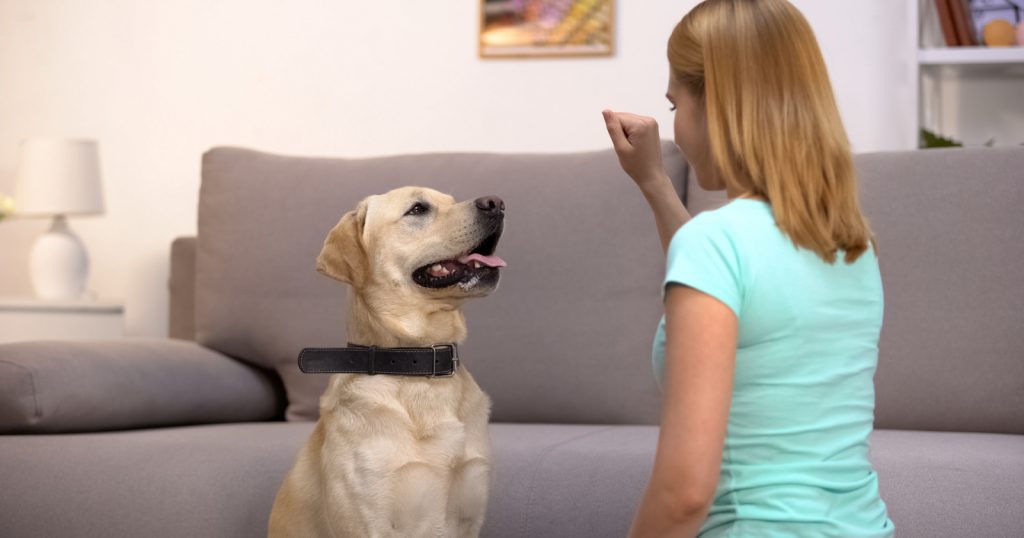Are you wondering how much in-home dog training cost?
You might be struggling to find the right dog training classes and considering home dog training services.
Fortunately, we’re here to tell you everything you need to know about private dog training and online dog classes.
Just keep on reading.

How Much Does In-Home Dog Training Cost?
Obedience training is necessary for all dogs to teach them manners and curb any unwanted behaviors.
While you can find tons of books about training your dog, it can be a daunting task for first-time owners.
If you’re thinking about in-home training rather than group training classes and boot camps, the expenses might be one of the deciding factors.
But we’re also going to cover the pros and cons of in-home dog training to help you make an informed decision.
What Determines the Cost of In-Home Dog Training?
I can tell you from the start that private dog lessons are more expensive than group ones and less expensive than obedience school or dog boot camp.
On average, you can expect to pay around $120 per lesson for in-home training, but the price might reach $400.
It depends on several factors:
- Age. It’s one thing to train a puppy and another to teach an adult dog with behavior problems. So, some private trainers might have different prices for puppies and adults.
- Location. As you can imagine, dog trainers in the big cities will probably charge more than a small-town professional. Moreover, traveling to a client’s house will also increase the price of the lesson.
- What training you need. Basic obedience training will be cheaper than advanced obedience training or dealing with aggressive behavior.
- The number of sessions and their length. Some trainers might offer discounts for more than one lesson. Short sessions also tend to be cheaper than long ones.
For example, PetSmart has private dog training lessons for $89 per hour or $219 for four hours ($54,75 per hour). They also offer a 30-minute training session for $45.
On the other hand, Tucker Pups offers $125 per single lesson or $100 per lesson if you pre-pay for 10 sessions.
In comparison, dog training classes start from $30 to $75 per session. Usually, a 5-6-week course will be around $200-$300, but it might go as high as $400.
PetSmart’s basic obedience package, for example, is $119 for a 6-week basic obedience training.
How Much Do Online Dog Training Lessons Cost?

Since we’re talking about how much in-home dog training costs, we can’t miss talking about online dog classes.
A lot of dog owners probably don’t know that there’s such a thing as online dog classes.
They’re relatively new in the dog training world, but such courses can be beneficial for busy people.
As a whole, online classes provide you with videos on dog training and allow you to chat with professional trainers.
You can check Udemy.com for dog training classes, Cyber Dog, or Google search for online dog classes.
Usually, the cost of online dog training classes is around $90, but it can as high as $350 per lesson/course.
So, it’s not much cheaper than private dog training, and some owners find it more challenging.
What are the Pros of In-Home Training?

You’re probably wondering if it’s worth paying so much for in-home dog training.
That’s not an easy question to answer, and it depends on your dog’s temperament and what you expect of them.
In general, in-home dog training is more suitable for:
- Dogs that have trouble concentrating or keeping up with the class
- Aggressive/anxious dogs that get triggered in a noisy environment
- Dogs with specific behavior problems
- Unvaccinated puppies
The benefits of in-home training include the convenience of having the training sessions take place in the comfort of your own home, the undivided attention of a professional trainer, and customized training plans that cater to your dog’s unique needs. Let’s break those down and discuss them in a bit more detail.
Convenience & a training Schedule That Fits YOUR Needs
The biggest advantage of in-home training is that you can schedule the sessions when you have the time and reschedule if necessary.
You don’t have to worry about missing the class or that you’re going to be late.
Undivided Attention of a Professional trainer
Having an in-home dog trainer’s undivided attention can be a significant benefit compared to attending group dog training lessons. In group training classes, trainers have to divide their attention among multiple dogs and owners, which can limit the amount of individual attention and instruction each dog and owner receives.
In-home training, on the other hand, provides the opportunity for a trainer to focus solely on your dog’s behavior and needs, and to tailor the training to your specific goals and concerns. This can lead to a more efficient and effective training process, as the trainer can provide immediate feedback and adjust the training plan as needed.
Plus, you can ask them all the questions you might be embarrassed to ask in a group class and move things at a comfortable pace for you and your dog.
training that’s customized to your dog’s unique needs
Moreover, in-home training is tailored to your dog’s specific needs. A basic obedience class won’t help you deal with reactivity, separation anxiety, or aggressiveness, for example.
Having an in-home dog trainer create a custom plan for dealing with your dog’s behavior issues can be incredibly beneficial. Every dog is unique and has its own personality, habits, and issues.
By having a professional trainer assess your dog’s behavior in his natural environment, they can create a customized training plan that addresses your dog’s specific needs. The trainer can identify the root cause of your dog’s behavioral issues and create a plan that focuses on modifying those behaviors.
This personalized approach can be much more effective than a one-size-fits-all approach that is commonly used in group training classes.
Additionally, the trainer can teach you techniques and provide guidance on how to reinforce the training in between sessions, so you can continue to work on your dog’s behavior and maintain the progress achieved during the training.
Overall, having an in-home dog trainer create a custom plan for your dog’s behavior issues can lead to a well-behaved and happy dog and a harmonious relationship between you and your pet.
What Are the Cons of In-Home Dog Training?

As you can see, in-home dog training has many pros, and it can be an excellent solution to managing an unruly dog.
However, private lessons also have disadvantages, and you have to consider the cons of in-home dog training before you make up your mind.
Cons of using an in-home dog trainer can include cost, lack of socialization opportunities for the dog, and potential limitations in the trainer’s expertise and training techniques. Again, let’s take a closer look at each of these drawbacks.
Cost
Let’s be real for a moment, in-home dog training isn’t exactly cheap. The personalized attention and customized training plans come with a higher price tag than group training classes.
So, it makes sense that cost is the #1 drawback of in-home dog training. It can be challenging for some pet owners to justify the investment, especially if they are on a tight budget.
Lack of Socialization Opportunities
Another potential drawback is the lack of socialization opportunities for the dog. Group classes, obedience schools, and dog boot camps allow your dog to socialize with other animals and people.
In-home training sessions only involve the trainer, the owner, and the dog, which means the dog may not have the chance to interact with other dogs and people.
This can be particularly challenging for puppies, who need exposure to different environments and stimuli to develop social skills. In other words, where group classes expose your pet to various stimuli and triggers and help your dog get used to new smells, sounds, and people, in-home training doesn’t.
In group classes, your dog also learns how to behave by interacting with other dogs and acquires important social skills. That’s vital for a pet to become a good citizen and grow up into a mellow dog.
The bottom line is that by choosing in-home training, you’re going to miss a great chance for socializing your dog and getting them comfortable around other dogs.
Limitations in Both Trainers and training
Lastly, while in-home trainers can be experts in dog training, they may have limitations in their expertise and training techniques.
If a dog has particularly complex behavior issues, the trainer may need to refer the owner to a specialist. Additionally, some trainers may rely on outdated or overly aggressive training techniques, which can harm the dog and damage the owner-dog relationship.
Moreover, in-home trained dogs might not respond to your orders when you’re outside the home. That’s because the outside is full of distractions, and it’s hard for a dog to focus on what you want from them.
On the other hand, group classes are usually full of distractions, which helps a dog learn to concentrate and listen to you in a chaotic environment.
You’re also going to miss the opportunity to share your experience with other owners and learn important training tricks and secrets.
In group classes, some owners might ask questions you’ve never thought of and have unique methods for managing their dogs.
Pros and Cons of Online Dog Classes
Online dog training courses usually provide you with training videos that you can watch in your free time and then repeat the steps with your dog.
Being alone with your dog might be less stressful for both of you and improve the training results.
Moreover, you can schedule online meetings with the trainer at a convenient time and work things at a comfortable pace.
Still, online dog classes have the same disadvantages as in-home training.
Your dog doesn’t get much socialization, and you can’t benefit from shared learning.
But online training also lacks the personal contact with the trainer.
It’s one thing to see how training is done on video and another when the trainer is right next to you and can point your mistakes.
As you can see, how much in-home dog training costs depends on several factors. It has a lot of advantages, and it’s a great choice for busy people and some dogs.
FAQs About In-Home Training for Dogs
We went over many of these questions in more detail above, but sometimes you just want a quick and to-the-point answer, right? So, let’s close out with a few quick FAQs.
In-home dog training involves a professional trainer visiting your home to provide personalized training sessions for your dog.
Benefits include personalized attention from a trainer, customized training plans, convenience, and targeted training to address specific issues.
Costs vary depending on the location, trainer, and the number of sessions required, but it is generally more expensive than group training classes. Sessions typically start at $100 an hour and each one lasts between 60-90 minutes. However, both the cost and the length can vary depending on the trainer’s approach and the dog’s needs.
The number of sessions required depends on the dog’s behavior and needs, but it typically takes 4-6 sessions to see progress.
You have to decide for yourself whether to pros outweigh the cons. However, when you compare in-home dog training to other types of training, it definitely comes out ahead in all aspects aside from socialization.
In-home dog training can be a great investment for dog owners who want to improve their dog’s behavior and obedience but don’t really have the time or transportation to get to regular in-person classes.
Ongoing training is essential to maintain progress, reinforce good behavior, and prevent regression. In-home training can provide the foundation for ongoing training.
Look for a trainer with relevant experience and qualifications, positive training techniques, and good reviews and recommendations from other pet owners. You can also ask your vet or even your local animal shelter for recommendations.
What do you think about in-home dog training? Tell us about your experience in the comment section.



Training for dogs can be so fun. My dog loves training and every time I have the treats and he would be so attentive and patient.
My bestie just got a 6-month old pup so will be sharing this post with her as she has been saying that she wanted to train her pup
I have always found dog training quite easy following “The Loved Dog’ methods. But, I suppose some people need classes / in house training themselves.